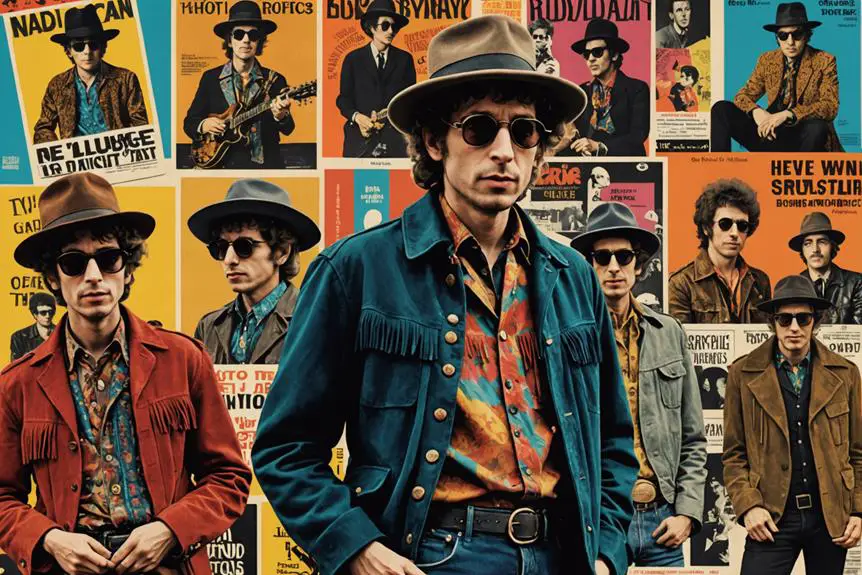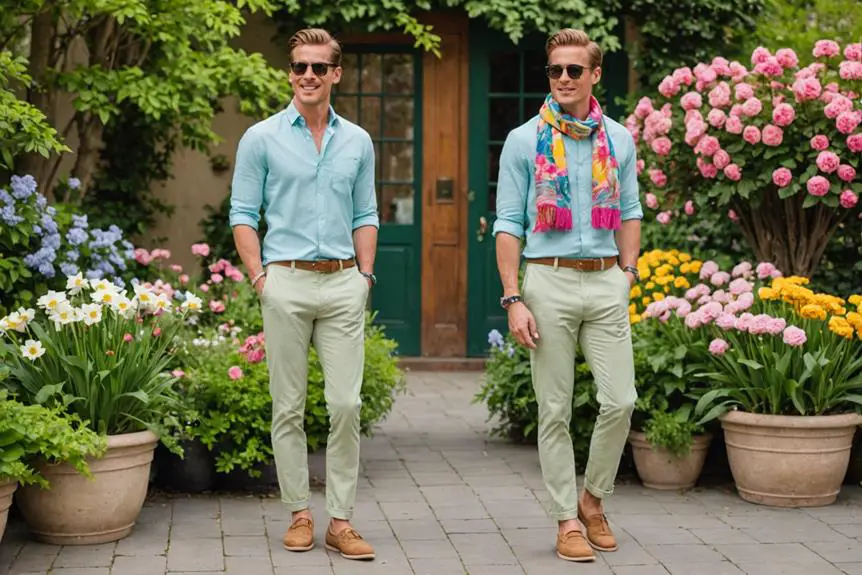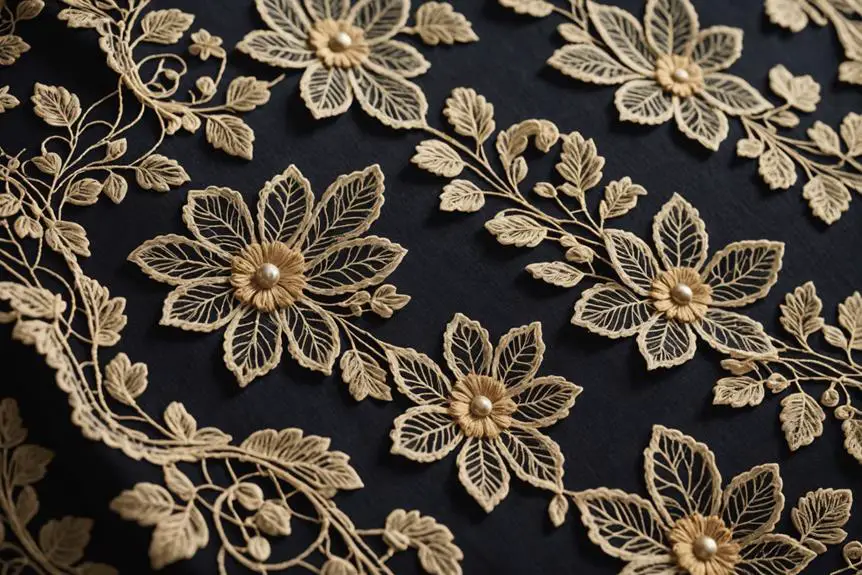When you think about Bob Dylan, his music likely comes to mind first, but his fashion choices have been just as influential. You might notice how his style has evolved over the decades, reflecting shifts in both culture and personal identity. From the rugged looks of the 1960s to the sophisticated ensembles of the 1980s, each phase tells a story. What's intriguing is how these choices resonate today, influencing modern artists and designers. So, how did Dylan's wardrobe become a canvas for his artistic expression?
Early Influences on Dylan's Style
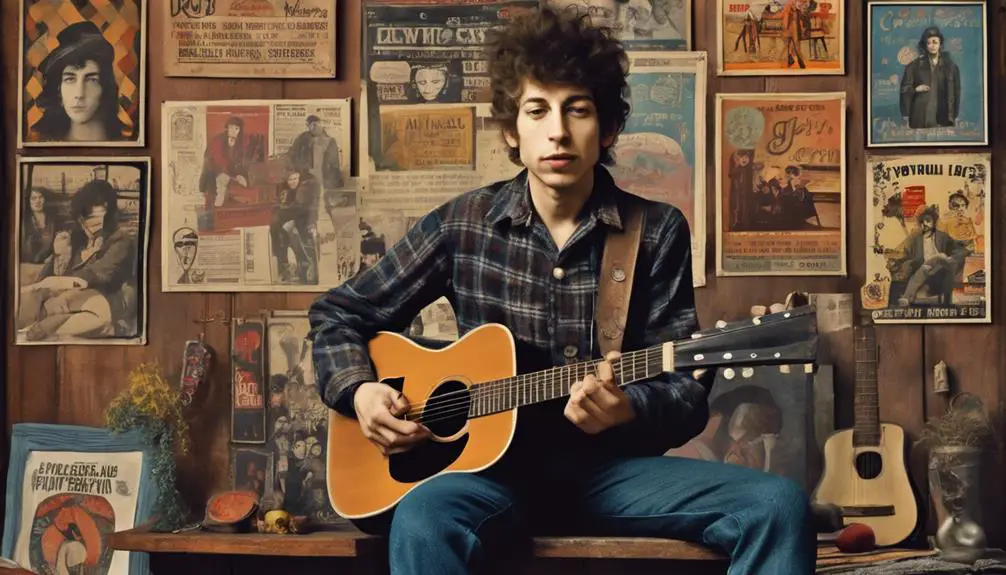
Drawing inspiration from his working-class roots, Bob Dylan's early style reflected the practicality of his upbringing in Hibbing, Minnesota. He embraced fashion choices that embodied the essence of the everyday man, favoring practical clothing like denim and flannel shirts. These garments not only showcased his humble beginnings but also resonated with the folk music revival of the early 1960s, a movement he admired deeply, particularly through the lens of Woody Guthrie.
Dylan's debut album, "Bob Dylan," released in 1962, highlighted this straightforward aesthetic, featuring button-down shirts and casual wear that perfectly aligned with the ethos of the folk scene. His iconic style was a reflection of the rugged simplicity that characterized the working-class experience. Thrift store finds became his go-to, emphasizing a no-frills approach that spoke volumes about his authenticity and connection to his roots.
As you explore Dylan's early influences, you'll notice how his choices were more than just fashion statements; they were a declaration of his identity. This down-to-earth approach attracted fans who felt a kinship with his look and his music. The combination of practicality and artistry in Dylan's early wardrobe laid the foundation for the iconic style he would eventually evolve into. His fashion choices during this formative period weren't just about aesthetics; they were an essential part of his narrative, marking the beginning of a legendary journey that would transcend music and fashion alike.
The Transformation in the 1960s
As the 1960s unfolded, Bob Dylan's fashion began to mirror his artistic evolution and the cultural upheaval of the era. Early on, you might've noticed Dylan's style reflected his Midwestern roots with simple button-down shirts and denim, perfectly aligned with his folk music beginnings. However, everything shifted dramatically with the release of "The Freewheelin' Bob Dylan" in 1963, where his confident look emerged, complete with bold striped t-shirts that signified a departure from his earlier simplicity.
By the mid-60s, you could see a transformation in Dylan's wardrobe, characterized by eclectic choices that showcased his growing confidence as a rock icon. He embraced frilly polka dot shirts, Cuban heels, and double-breasted coats, all of which highlighted his artistic daring and individuality. The 1966 tour marked a pivotal point, as Dylan adopted a more rebellious aesthetic, donning leather jackets and sunglasses. This new look not only cemented his status as a fashion-forward musician but also resonated deeply with the counterculture of the time.
As the decade drew to a close, Dylan's style evolved further, incorporating bold patterns and textures that reflected the changing cultural landscape. Each outfit told a story, demonstrating how Dylans style was not just about clothing but an extension of his artistic identity. This transformation during the 1960s remains a defining chapter in both his fashion legacy and musical journey.
Bold Choices of the 1970s
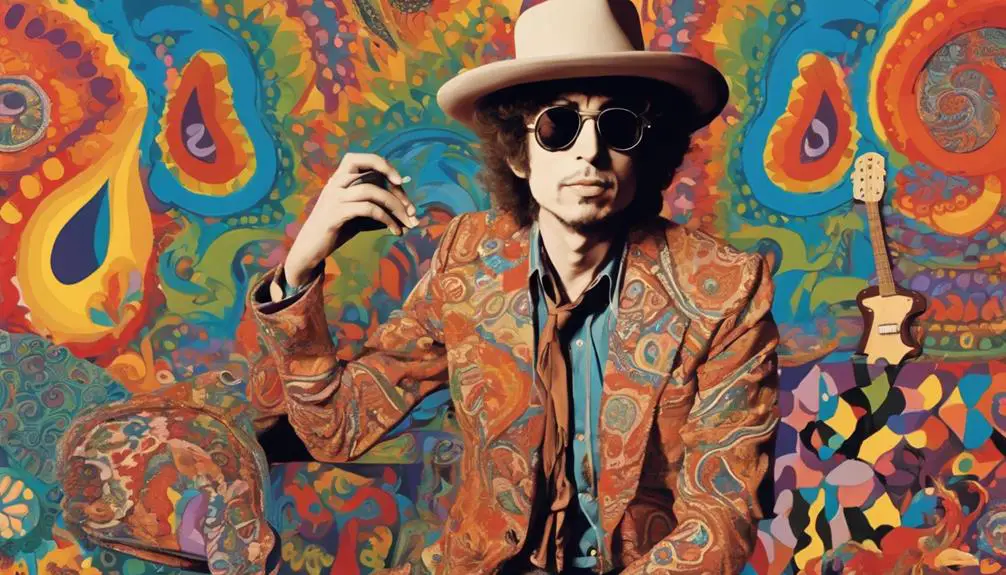
The 1970s saw Bob Dylan fully embracing a bold and eclectic fashion sense that captivated fans and critics alike. During this vibrant decade, Dylan transformed his wardrobe into a canvas of self-expression, particularly during his iconic Rolling Thunder Revue tour. He donned wide-brimmed hats, scarves, and layered clothing that exuded a gypsy-inspired aesthetic, making each performance a visual spectacle.
His outfits featured structured oxford shirts paired with leather jackets and flared bellbottoms, illustrating a seamless blend of rock and roll flair while staying true to his folk roots. Dylan wasn't afraid to experiment, often showcasing bold patterns and vivid colors that turned heads. Embroidered shirts and statement jewelry became staples, enhancing his overall look and solidifying his status as a style icon of the era.
This period marked a significant departure from his earlier, simpler styles. Dylan began integrating tailored suits into his wardrobe, showcasing his evolution not just as a musician but as a fashion innovator. Notable performances, such as his appearances at the Isle of Wight Festival, highlighted his innovative fashion choices, resonating deeply with the counterculture movements of the time.
With each bold choice, Dylan not only redefined his image but also influenced countless fans and fellow artists. His fearless embrace of unique fashion elements set the stage for future generations, proving that in the world of music and style, authenticity reigns supreme.
The Polished Look of the 1980s
After the bold and eclectic fashion choices of the 1970s, Bob Dylan entered the 1980s with a more refined approach to style. This decade marked a significant evolution in the Bob Dylan style, characterized by tailored suits and vibrant patterns that exuded sophistication. Dylan embraced a polished aesthetic, layering different textures to create unique outfits that were both elegant and edgy.
Here are four standout elements of his 1980s fashion:
- Tailored Suits: Dylan often donned perfectly fitted suits that accentuated his figure while allowing him to stand out in any crowd.
- Statement Accessories: Oversized cuffs in tuxedos and Western string bow ties showcased his flair for individuality, elevating formal wear to a new level.
- Daring Prints: The use of animal prints added a bold touch, demonstrating Dylan's commitment to making a fashion statement while also reflecting his artistic spirit.
- Iconic Sunglasses: His blacked-out aviators became a signature accessory, reinforcing his cool persona and adding an edgy twist to his polished looks.
Dylan's distinct grooming choices, paired with these fashion elements, highlighted his confidence and unique style during this period. The 1980s showcased a Bob Dylan who was not just a musical icon but also a fashion trendsetter, proving that a polished look can still carry the essence of individuality and artistic expression.
Americana Revival in the 1990s
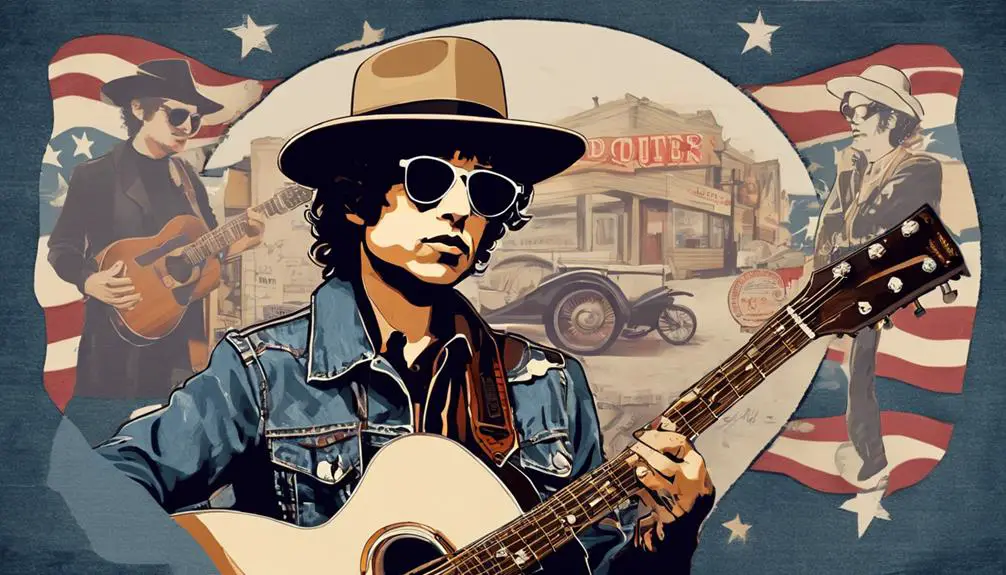
In the 1990s, Bob Dylan's wardrobe reflected a vibrant revival of Americana, showcasing a blend of classic Western wear and timeless pieces that echoed his roots. You'd notice him in denim jackets, cowboy boots, and embroidered shirts, all of which highlighted a return to simplicity and authenticity. Dylan's style during this decade emphasized durable and enduring garments, deeply resonating with his working-class background.
His performances often featured stripped-down looks, merging sophistication with a rustic aesthetic, particularly through tailored suits and bolo ties. This combination not only elevated his stage presence but also reinforced his status as a cultural icon. One standout moment was the 1994 MTV Unplugged session, where his affinity for polka dots and plaid patterns shone through. These choices connected him to traditional American fashion while enchanting a new generation of fans.
Throughout the 1990s, Dylan's style choices inspired contemporary musicians and designers, proving that his influence in the intersections of music and fashion was far-reaching. His Americana style emerged as a beacon of authenticity, encouraging countless artists to explore their roots and embrace a more grounded aesthetic. The revival wasn't just about clothes; it was a celebration of heritage, culture, and the timeless appeal of classic Americana. So, whether you're drawn to his bolo ties or the rugged charm of his Western wear, it's clear that Bob Dylan left an indelible mark on fashion that continues to inspire today.
Modern Style Trends in the 2000s
Throughout the 2000s, Bob Dylan's style evolved to blend traditional Western wear with modern elements, setting a standard for contemporary fashion. You can see how he embraced this modern style through a variety of fashion choices that showcased his unique personality while paying homage to classic Americana. His looks often featured tailored Western wear, which included striking collar styles, like banded collars and embroidered shirts. These details highlighted his distinctive aesthetic and timeless appeal.
Here are four key aspects of Bob Dylan's modern style during this decade:
- Leather Jackets: Dylan frequently donned leather jackets, adding a rugged yet sophisticated edge to his outfits.
- Darker Color Palettes: His preference for darker colors created a moodier, more refined appearance that resonated with his musical themes.
- Unique Accessories: Gambler hats, scarves, and sunglasses weren't just add-ons; they were essential elements enhancing his iconic status in the fashion world.
- Textured Fabrics: The use of varied fabrics contributed to a layered look, expressing both comfort and style.
Dylan's fashion choices during this period didn't just reflect his personal style; they also inspired countless designers and artists, reinforcing his status as a cultural icon. His modern style continues to resonate today, proving that true fashion transcends time and trends. So, whether you're channeling Dylan for a casual outing or a more polished event, his influence remains as relevant as ever!
Iconic Performance Outfits

When you think of Bob Dylan's performances, his outfits often steal the spotlight just as much as his music. From the moment he stepped onto the stage in 1966, wearing a black leather jacket and sunglasses, he established a rugged yet sophisticated aesthetic that became iconic in rock fashion. This combination not only highlighted his rebellious spirit but also set a precedent for musicians who followed.
At the Isle of Wight Music Festival in 1969, Dylan took a bold step into flamboyance with a double-breasted coat and flared trousers, showcasing his evolving stage presence. His 1978 tour saw him favoring denim jackets layered over colorful shirts, often an oxford shirt, blending casual Americana with rock 'n' roll flair. This look was both memorable and approachable, allowing fans to connect with his artistry on a deeper level.
Fast forward to 1984, and Dylan wowed audiences at the Grammy Awards in an oversized tuxedo jacket, paired with a unique Western string bow tie, contrasting traditional styles with his distinct persona. Then, during his 1994 MTV Unplugged session, he revisited polka dots, donning a distinctive polka-dot shirt that echoed his earlier fashion influences while remaining fresh and contemporary.
Dylan's iconic performance outfits aren't just about clothing; they reflect his artistic evolution and the ways in which he continually reinvents himself. Each ensemble tells a story, making his performances not just auditory experiences but visual spectacles as well.
Lasting Legacy in Fashion
Bob Dylan's fashion legacy has left an indelible mark on the music and style worlds, transcending decades and inspiring countless artists. His eclectic approach to style not only defined his persona but also shaped the broader music scene. From tailored suits to rugged leather jackets, Dylan's wardrobe reflects a unique blend of sophistication and rebellion, making him a lasting style icon.
You might notice how Bob Dylan's influence manifests in various ways, such as:
- Timeless Accessories: His signature Ray-Ban Wayfarers and distinctive hats have become symbols of cool, often replicated by fans and fashion enthusiasts alike.
- Genre-Blending Aesthetic: Dylan's style has permeated multiple genres, influencing punk, grunge, and indie movements, with modern artists drawing from his eclectic looks.
- Fashion Exhibitions: Museums and galleries celebrate his artistic vision through exhibitions, showcasing how his personal style intersects with music, reinforcing his cultural significance.
- Inspiration for Designers: Contemporary designers continue to reference Dylan's fashion choices, integrating elements of his aesthetic into their collections, ensuring his legacy remains vibrant.
Dylan's lasting impact on the fashion world is a reflection of his ability to intertwine personal style with musical expression. His iconic looks continue to inspire new generations of musicians and fashion lovers alike, proving that Bob Dylan's style will always resonate, echoing through the ages in the ever-evolving landscape of fashion.
Frequently Asked Questions
What Was Bob Dylan Most Famous For?
You know Bob Dylan's most famous for his lyrical innovation, which transformed songwriting. His cultural impact during the 1960s and musical evolution from folk to rock shaped generations, influencing countless artists and social movements.
When Did Bob Dylan Change His Style?
You'll notice Bob Dylan's style changed considerably during the 1960s shift, evolving into a 1970s reinvention. His looks embraced a modern aesthetic, blending eclectic elements with polished details that defined his evolving fashion sense.
Who Is Bob Dylan's Biggest Influence?
You'll find that Bob Dylan's biggest influence stems from Woody Guthrie's storytelling, which shaped his musical evolution. His literary influences, like Dylan Thomas, and cultural impact resonate throughout his work, enriching his artistic expression.
What Was Bob Dylan's Main Message?
Bob Dylan's main message revolves around social commentary, where you find lyrical themes that challenge norms. His cultural impact inspires you to reflect on justice, equality, and the importance of questioning authority in society.
